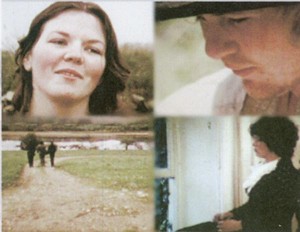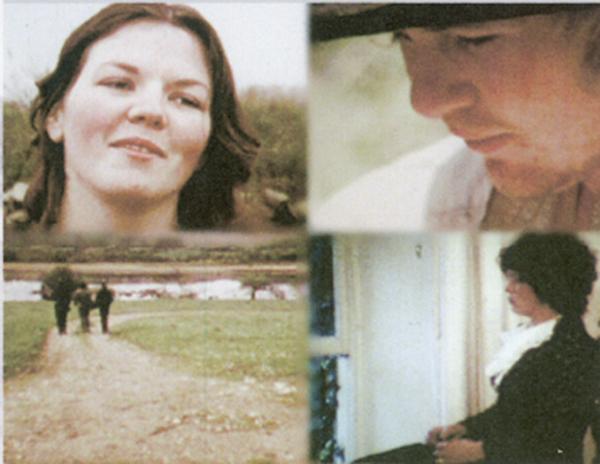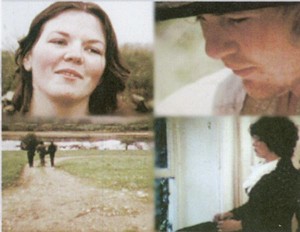From Monthly Film Bulletin, December 1976 (Vol. 43, No. 515). — J.R.
Coilin & Platonida
Great Britain, 1976
Director: James Scott
The 1920s. Thrown out of the house by her uncle, Aksinya marries her lover, a sexton, and five months later gives birth to a son, Coilin. After the sexton drowns in a stream, she works as a servant to nuns, introducing and dressing Coilin as a little girl. Entering school at the age of twelve, Coilin is expelled for backwardness, and finds work as an apprentice to various craftsmen. After three years in the army, he returns to find his mother dead and is turned away from his uncle’s house. Visiting two orphaned boys who are distant relatives and finding them hungry and maltreated, he takes them under his wing and persuades his cousin Platonida to give them clothes. Settling in with the children in an unused room at Granny Rochovna’s cottage, he sells home -made polishand ink, does odd jobs, and applies unsuccessfully for work at the postoffice. Given an island by the town council, he builds a hut and teaches the boys to read. Four years later, Platonida’s husband dies, and her father-in-law promises to leave her his fortune. One night, she finds her father-in-law crouching outside her bedroom window; after she lets him in and he tries to rape her, she strikes at him with a cleaver and runs away, believing that she has killed him. But he proves to be alive, accuses Platonida and his son Avenir of attacking him, and has the latter arrested; the police search Coilin’s hut and arrest him as well. Accused of being a witch and rumored to have turned into a fish, Platonida is taken in by nuns and becomes a nun herself. Before Avenir joins the army, she bids his farewell; eventually she becomes blind.
A curious and singular adaptation of a story by Leskov that is no less curious and singular, James Scott’s Coilin & Platonida employs most of the ingredients of narrative while often contriving to suggest that its true interests lie elsewhere. Originally shot in super-8 and then refilmed in 16 mm. while the footage was projected — a method that allows two or more adjacent images to share the frame on certain occasions — this principally silent color film is largely founded on interactions between a 19th century Russian folk tale and the the people and places filmed by Scott in Connemara, on the west coast of Ireland, to which the title itself bears witness: the ’Kotin’ of the original story has become ‘Coilin’ simply because that is the name of the lead actor who plays the hero as a young man. But most striking of all, within the terms of this two-way flow, is the remarkable use of super-8 that the film develops in the exploration of textures, tonalities and nuances, creating an inimitable form of discourse with its own kinds of mysteries and ambiguities. Quite in keeping with Scott’s work in the Berwick Street Collective as exemplified by The Nightcleaners, Coilin & Platonida lingers over faces, landscapes, ‘empty’ moments and spaces with an intensity which appears to function at oblique angles to the ostensible subject matter. A suite of interrogations and discoveries develops from this process, separated by fades, intertitles, and patches of black leader with single colored lines accompanied by a solo singing voice — devices ,which serve almost equally as ellipses, isolating certain shots and sequences in such a way that each is offered for independent contemplation, in contrast to the compulsive linearity of the narrative elements organizing them. (By carrying the weight of the story proper, the intertitles — closely derived from the original story — tend to let the intervening images speak and fend for themselves.) Thus two slightly overlapping formal ‘portraits’ of Aksinya, the sexton and their mule in a single image serves as one abstract definition of a family unit, while a grainy, almost pointillist shot of Aksinya walking with Coilin at age twelve comprises another. Perhaps even more memorable is the zoom that follows Coilin, back from the army, out of the front door of his uncle’s house where he is rejected (with the family standing in the foreground), disappearing into a whiteish background — a haunting moment whose narrative movement is defined by absence as much as presence. Subsequently, multiple images of different aspects and stages of Coilin’s building of a hut arrest and expand the narrative in still other ways, and Scott’s supple use of super-8 is nowhere more apparent than in this inventive sequence, which profitably includes a fragment of ‘overexposed’ footage (showing one of the boys playing by a stream)-and concludes with a long zoom away from Coilin beside his completed hut. This image then recedes within the frame before the zoom moves forward again, playing with the relative degrees of the spectator’s distance. By the time one arrives at the climactic attempted rape of Platonida by her father-in-law — shown in highly elliptical snatches –- the story itself has become virtually illegible, and one must consult Leskov’s original in order to spell out much of the implied action, making portions of the above synopsis more hypothetical than real.
In Walter Benjamin’s fascinating study of Leskov in Illuminations, it is argued that storytelling has a communal relationship with its audience that novel-reading and novel-writing lack, that “nothing , . . commends a story to memory more effectively than that chaste compactness which precludes psychological analysis”, and that a story, unlike ‘information’, “preserves and concentrates its strength and is capable of releasing it even after a long time”, precisely because its meanings shift with the emphasis of different periods and audiences. Substituting ’cinema’ for ‘story’, one arrives at apart of the paradoxical nature of Scott’s achievement. The ‘timeless’ poetry of Coilin & Platonida — grounded in 19th century Russia, realized in 20th century Ireland — seems largely predicated on Benjamin’s conditions, reformulated as they are; and spectators who stumble over the ambiguous and elusive ‘story’ searching for ‘answers’ might be advised to look longer and harder, a process that the film itself encourages.




